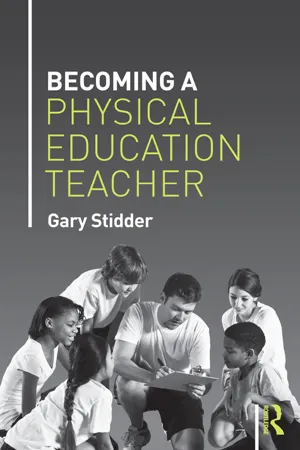
- 206 pages
- English
- ePUB (mobile friendly)
- Available on iOS & Android
Becoming a Physical Education Teacher
About this book
Teaching physical education is a challenging but rewarding occupation. Finding a way into the profession can be a daunting task while regular changes in government policy can make it hard to stay up to date. This engaging new book explains the process of becoming and being a teacher of secondary school physical education, from the various routes of entry into the profession, to the realities of being a qualified PE teacher, to the ways in which experienced teachers can become teacher educators and nurture the next generation. It combines rich personal accounts of teaching in, and being taught, physical education, with practical advice for trainees, newly qualified teachers and established professionals, with an emphasis throughout on the importance of critical self-reflection.
The book begins by exploring the nature and purpose of physical education and examining the historical development of initial teacher training. It examines recent changes in training, policy and curriculum, and offers an overview of the various ways of becoming a PE teacher, including the Post Graduate Certificate in Education (PGCE) and school and employment based routes. The book offers advice on what to expect at interview, meeting the standards for qualifying to teach, and on how to survive the difficult first year as a newly-qualified teacher. It also outlines the challenges and rewards of being a qualified teacher, mentor or curriculum leader, as well as a teacher educator within higher education.
Concise, helpful, and filled with sensible insights based on real experiences of teaching physical education, Becoming a Physical Education Teacher is an essential read for anybody considering entering the profession, or for students, trainees, newly qualified or experienced teachers wanting to understand better the process of becoming, and being, a successful PE teacher.
Frequently asked questions
- Essential is ideal for learners and professionals who enjoy exploring a wide range of subjects. Access the Essential Library with 800,000+ trusted titles and best-sellers across business, personal growth, and the humanities. Includes unlimited reading time and Standard Read Aloud voice.
- Complete: Perfect for advanced learners and researchers needing full, unrestricted access. Unlock 1.4M+ books across hundreds of subjects, including academic and specialized titles. The Complete Plan also includes advanced features like Premium Read Aloud and Research Assistant.
Please note we cannot support devices running on iOS 13 and Android 7 or earlier. Learn more about using the app.
Information
APPENDIX 1: SURVIVING YOUR PGCE YEAR
Term 1 (hold on tight)
Term 2 (keep it up)
Term three (so close)
APPENDIX 2: PAY SCALES OF TEACHERS
Head teachers
Leadership spine
Advanced-skills teachers
Excellent teacher
Unqualified teachers
General teaching scales
Classroom teachers
Teaching and learning responsibilities
Vignette (current curriculum leader for physical education)
BIBLIOGRAPHY
- Almond, L. and Ezzeldin, K. (2013) ‘Are Fundamental Movement Skills the Foundation of Physical Education?’, Physical Education Matters, 8(3): 53–5.
- Amateur Swimming Association (2013) Learning the Lesson: The Future of Swimming. The 2013 School Swimming Census. Loughborough: ASA. Available online at www.swimming.org/assets/uploads/library/School_Swimming_Census_2013.pdf (accessed 25 September 2014).
- Amour, K. and Chen, H.K. Amour and D. Macdonald (2012) ‘Narrative Research Methods: Where the art of storytelling meets the science of research’, in K. Amour and D. Macdonald (eds), Research Methods in Physical Education and Youth Sport, Abingdon: Routledge, 237–49.
- Armour, K. and Jones, R. (1998) Physical Education Teachers’ Lives and Careers, London: Falmer.
- Armour, K. and Yelling, M. (2004) ‘Continuing Professional Development for Experienced Physical Education Teachers: Towards Effective Provision’, Sport, Education and Society, 9(1): 95–114.
- Armour, K., Chambers, F. and Makopoulou, K.S. Capel and M. Whitehead (2013) ‘Conceptualising Teaching as Learning: The Challenge for Teacher Education’ in S. Capel and M. Whitehead (eds), Debates in Physical Education. Abingdon: Routledge, 205–19.
- Armour, K., Makopoulou, K., Chambers, F. and Duncombe, R.R. Bailey (2010) ‘Career-long Professional Learning for the Professional Physical Education Teacher’ in R. Bailey (ed.), Physical Education for Learning: A Guide for Secondary Schools. London: Continuum International, 37–53.
- Association for Physical Education (2013) Health Position Paper. Wo...
Table of contents
- Cover
- Half Title Page
- Title Page
- Copyright Page
- Dedication Page
- Table of Contents
- Foreword: ‘Becoming Mr Sugden’
- Acknowledgements
- List of abbreviations
- Glossary of terms
- Introduction
- SECTION ONE What you need to know
- SECTION TWO The journey ahead
- SECTION THREE Moving on
- Appendix 1: Surviving your PGCE year
- Appendix 2: Pay scale of teachers
- Bibliography
- Index